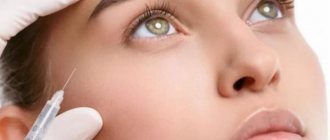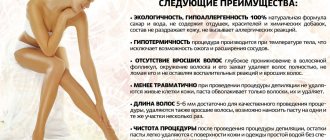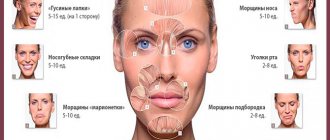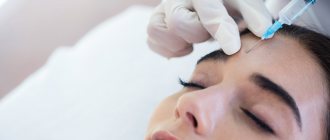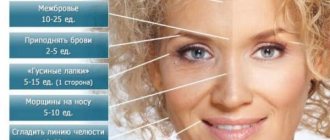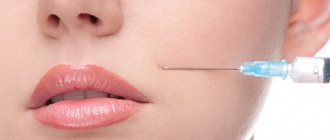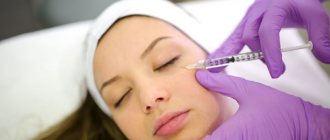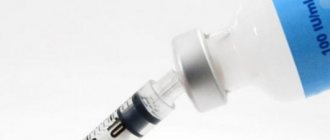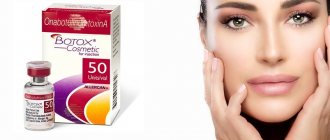Botox - principle of action and its effectiveness
Botox is a drug created 35 years ago by Allergan (USA) for the treatment of spastic tics after strokes and cerebral palsy. It contains the neurotoxin of the causative agent of botulism (botulinum toxin). When administered intramuscularly, it blocks the nerve endings and causes temporary paralysis of that muscle.
When administered to patients for medical reasons, a cosmetic effect was also noticed - smoothing out wrinkles due to immobilization of facial muscles. The effect of the drug is long-lasting, at least 4 months. That is why Botox injections have become the most popular means of “returning” a youthful face all over the world.
How to determine your individual dosage
In each case, the injection points and dosage of the drug are determined individually. To do this, before the procedure, the cosmetologist performs a special examination. The patient is asked to tense the muscles in the intended injection area. For example, frown your eyebrows, wrinkle your forehead. Taking into account the formation of wrinkles during facial expressions, the doctor determines how much of the drug is best to inject into what point.
In addition, the density of the skin, skin type, the depth of existing wrinkles, the activity of a person’s facial expressions as a whole, and his age are taken into account. Also, men have thicker skin and require a much higher dosage.
After assessing all these parameters, the cosmetologist calculates the required amount of the drug for each zone (and injection point) and makes injections. For initial administration, the dosage is slightly higher than for repeated administration, but not more than 250 units in total.
After the full effect has developed, at a follow-up appointment 2 weeks later, the doctor checks whether the administered dose of Botox was enough and whether the face looks symmetrical during facial expressions. If correction is necessary, several more units of the drug are administered.
Reviews
Nadezhda, 28 years old, Ivanovo
“I started getting wrinkles when I was 25. I went to consultations twice, but it didn’t come down to injections. I was afraid. I studied the materials and read the reviews. Still, I decided. We applied Dysport to facial wrinkles on the forehead and between the eyebrows. One is deep. The injection sites were not anesthetized. First, they made 3 injections between the eyebrows. Then the forehead. On the first day after the procedure I had a headache. I felt numbness in my forehead after 4 days. Between the eyebrows - in a week. The facial expressions on the eyebrows remained a little. The largest wrinkle on my forehead smoothed out, but did not disappear. I liked the effect. Will I repeat it? I don't know yet. I think the face looks unnatural.”
Tamara, 45 years old, Pinega
“I wrinkle my forehead very much. Especially in the sun. The result is a deep crease between the eyebrows. I mustered up my resolve and went for a consultation at the clinic. The cosmetologist assessed the problem. She explained that she would make 20 units, because the crease is very pronounced. The injections were completely painless. The procedure lasted 7 minutes. Now I'm happy. Exactly 6 days later, a very small wrinkle remained from the crease. The cosmetologist suggested correcting it with hyaluronic acid, but I’m already happy with it. I got a great result!”
What happens if the dosage is incorrectly selected?
The correctness of the administered dosage is determined 2 weeks after the injections. There are only three scenarios here:
- The dosage is insufficient. Manifests itself with a weak effect or its absence. The wrinkles have not decreased, all facial expressions are preserved. If the patient followed the regimen after Botox administration, then there may be a weak sensitivity to this drug and a higher dosage is required.
- The dosage is excessive. In this case, the muscles completely lose mobility, and a “mask” effect appears. There is no facial expression, and due to the work of the remaining intact muscles when expressing emotions, the face can become distorted. This is an unpleasant consequence, but it does not pose a threat. After 4 months, the effect of Botox will begin to weaken and facial expressions will begin to appear again, as before.
- The dosage is generally correct, but! Cases of facial asymmetry in a patient are not uncommon. On one side, the muscle may attach differently than on the other, or may differ in length. Sometimes the person himself may raise one eyebrow more often, for example, or smile more on one side. If the cosmetologist did not see and take into account these individual characteristics, but introduced equal doses of Botox in both directions, the symmetry of the face may be disrupted. Thus, sometimes the injection into the right and left halves of the face needs to be done differently.
What is a unit of Botox
All drugs containing botulinum toxin are labeled with the number of units.
One unit of Botox is equivalent to a 100% lethal dose for mice when administered intraperitoneally. Dysport, for example, has less botulinum toxin content; 1 unit corresponds to a 50% lethal dose.
Why is such a unit needed? Using this, it is easy to understand in which zone how much of the drug was injected. It is not always convenient to navigate by milliliters, because bottles are produced in different volumes. The price in salons is also always indicated for 1 unit.
How much Botox is needed for different areas of the face and body
The drug is administered to different points in the muscles of the face, neck and body, in the area of which folds, creases, and wrinkles have appeared. Sometimes, Botox is administered to correct hyperhidrosis. Each zone has its own average values, which the cosmetologist focuses on. Places of administration:
- The jawline, to improve the oval of the face you will need 40-60 units.
- Neck (correction of transverse wrinkles and creases) 20-50 units, depending on the depth of wrinkles and folds.
- Armpits, correction of hyperhidrosis, 100 units on both sides.
- Palms, correction of hyperhidrosis, 60 units each.
- Feet, correction of hyperhidrosis, 60 units each.
But about the face we need clarification:
- forehead - transverse folds appear on it when the forehead is wrinkled or the eyebrows are raised, subsequently they turn into creases and wrinkles. Depending on the depth of the wrinkles, correction will require from 6 to 30 units,
- interbrow - folds and wrinkles appear when the eyebrows move; the “proud” muscle is located here. Correction requires 8-25 units.
- superciliary region - is involved in both frowning and wrinkling of the forehead, requires 5-15 units of the drug,
- the bridge of the nose - here wrinkles arise from the habit of squinting, here you will need 4-10 units,
- area around the eyes - with age, “crow’s feet” appear in the outer corners; 10-20 units of Botox are needed to correct them,
- the area around the lips is either wrinkles above the upper lip (purse-string), require 2-5 units, or drooping corners of the mouth 5-10 units.
- chin , you can lift it with 5-7 units.
Lose weight without denying yourself your favorite foods! Eat and lose weight! Find out how!
>>
Methodology
During the session, the cosmetologist will determine the depth of the problem and calculate the number of units of the drug. After asking the client to frown, he will determine the location of future injections and make markings with a special marker.
The correction site is disinfected with Chlorhexidine. Local anesthesia is done with a special cream.
Using a syringe, the drug is injected into the correction zones to a depth of 2-3 mm. The whole procedure takes from 3 to 5 minutes. After the injections, apply ice to the injection sites for about 15 minutes.
How much Botox do you need for the first time?
During the initial administration, an average dosage is given, after which you need to wait 2 weeks. Upon re-examination, the doctor assesses the severity of the effect and, if necessary, injects the required number of units.
If the patient injects regularly and is not coming for the first or second time, the Botox dosage is reduced. Firstly, there may be residual effects from the previous administration. And secondly, the habit of active facial expressions is gradually lost due to muscle immobility, and with it the severity of facial wrinkles also decreases.
Rehabilitation period
Rules for the rehabilitation period:
- Spend maximum time in an upright position, do not sleep on your stomach.
- Don't wear makeup.
- Do not drive for 24 hours.
- Do not drink alcohol for 2 weeks.
- Do not visit baths and saunas.
- Do not engage in intense sports.
What procedures are allowed to be combined with? Which medications can be combined with and which cannot?
Caution is required if antibiotics or aminoglycosides are used at the time of injection.
Minimize blood thinning medications if you cannot stop taking them completely. Dysport can be used in conjunction with hyaluronic acid injections into the nasolabial folds and lips. Read about which is better, Botox or hyaluronic acid, here.
How long does the effect last?
The manufacturer's instructions for the drug state that the duration of action is 4 months. This is the average time, which is influenced by various factors:
- blood flow at injection sites,
- general metabolic rate,
- the presence of antibodies to botulinum toxin in the body (previous botulism or vaccination against it),
- frequency of heating of the injection zone (insolation, baths, saunas accelerate elimination)
- the use of certain antibacterial drugs, as well as alcohol, can accelerate the onset of “awakening” of the muscles.
On average, a repeat procedure is usually required after about 6 months.
Contraindications
Since the active ingredient in Botox is a neurotoxin, the drug has many contraindications.
- Pregnancy at any stage and lactation. No studies have been conducted to determine whether botulinum toxin penetrates the placental barrier or into breast milk. Therefore, the risk to the child’s health in this case is not justified.
- Allergic manifestations, especially to protein substances.
- Myasthenic syndrome. A condition in which the contractile function of muscles is already impaired or weakened.
- Autoimmune diseases affecting the skin - scleroderma, systemic lupus erythematosus.
- Acute infectious diseases or exacerbations of chronic ones (viral infections, tuberculosis).
- Taking antibacterial drugs, anticoagulants, benzodiazepines.
- Infectious manifestations on the skin in the injection area, acne, furunculosis, psoriasis.
- Allergic diseases in the acute phase - seasonal asthma, urticaria, dermatitis, conjunctivitis.
- Poor vision, high degree of myopia.
- The recovery period after surgery is less than 2 weeks.
- Significant sagging of tissues, especially in the eyelids and jawline.
Compound
Dysport is an excellent, unparalleled remedy for wrinkles in the bridge of the nose, forehead and small wrinkles around the eyes associated with facial emotional manifestations.
The active component is botulinum toxin type A (hemagglutinin 500 units). As auxiliary components, the drug contains :
- Lactose.
- Human albumin.
Possible complications
Some complications arise during the procedure:
- Small hematomas and hemorrhages form at the injection sites.
- Pain at the injection points.
- Visible facial asymmetry due to uneven administration of the drug.
And some complications are a consequence of the introduction of botulinum toxin into the body:
Lose weight without denying yourself your favorite foods! Eat and lose weight! Find out how! >>
- Allergic reaction of varying severity.
- Lack of effect - 1% of people have immunity to this toxin and therefore the muscle relaxant effect of Botox does not manifest itself.
- Excessive effect, frozen face in case of overdose.
- Headaches range from mild to severe migraine-like.
- Double vision, blurred vision.
- Subcutaneous seals at injection sites.
- Drooping (ptosis) of the eyelids or eyebrows, swelling of the eyelids.
- Weakening of lip mobility.
- The appearance of creases when the points for Botox injection are incorrectly determined.
Lower eyelid
For this area, parameters such as skin quality, the presence of wrinkles and bags under the eyes are of great importance. The latter may result from laxity of the orbicularis oculi major muscle and are then classified as a pseudohernia. In case of significant bags under the eyes, patients are recommended to have plastic surgery.
Wrinkles on the lower eyelid are the result of hyperkinetic activity of the palpebral part of the orbicularis oculi muscle. In the pretarsal part, hypertrophy of the orbicularis muscle can form, affecting the opening of the eyelid. BTA preparations soften this thickening, which makes the eyelids open wider.
Assessing laxity of the lower eyelid skin is done by pulling the skin downwards. If, after retraction, the skin does not return to its original place, its elasticity is considered low. The optimal site for BTA injection is considered to be a point in the pretarsal part of the orbicularis oculi muscle on the central pupillary line. In this case, the aesthetic effect is achieved not only by reducing the wrinkles of the lower eyelid, but also by opening the eyes wider. The needle is inserted parallel to the skin until a superficial papule is formed with the BTA drug in a dosage of 1-2 units. Botox® or 2-4 units. Dysport® (Figure 9)
.
Figure 9. BTA injection points in the lower eyelid
Complications: BTA injections are not recommended for patients with dry eye syndrome, morning swelling of the eyelids and low skin elasticity. A negative elasticity test result is considered a contraindication for botulinum therapy. Injecting BTA too low or too deep can lead to bleeding and bruising, so it is recommended to use ice compresses. If BTA is inserted too deeply into the zygomaticus major muscle, lip asymmetry or cheek ptosis may form. As with the frontalis muscle, the palpebral region of the greater eye muscle should be relaxed rather than immobilized by BTA. The consequences of its complete immobility may be disruptions in the functioning of the lacrimal apparatus, cases of spontaneous closure of the eyelid, or the formation of a blink reflex.
BTA should be administered strictly into the central pupillary line. Injecting the toxin to the right of it can cause the eyelid to turn in and the outer corner of the eye to round. Administration of BTA to the left of the central pupillary line may result in involuntary lacrimation and dry eye syndrome.
Comment by cosmetologist, dermatovenereologist Ya. A. Yutskovskaya:
— When working with the lower portion of m.orbicularis oculi fibers, it is preferable to choose mesobotulinum therapy, in which botulinum toxin type A is injected in a higher dilution; injections are made very superficially. This injection method is not prescribed in medical technology, but, according to personal experience, it is very effective. The points that correct the lateral portion of the orbicularis oculi muscle are injected in accordance with the standard technique.
Alternative drugs
American Botox was the first drug of this kind and is widely used in cosmetology. In some countries, analogues of this drug have been released onto the market. The active ingredient in all is botulinum neurotoxin type A, which blocks nerve endings.
Indications for use are the same - combating wrinkles, age-related skin changes, increased oiliness and sweating. The contraindications are also the same, with differences in the allergic reaction to each individual drug. Preparation for injections and restrictions after it are the same for both Botox and its analogues.
Despite the similarities, there are also many differences between the analogues and the original:
- The size of botulinum toxin molecules differs in each drug, and the ability to distribute the drug in tissues, and therefore the effect of administration, depends on it.
- All analogues have different concentrations of botulinum toxin, so the number of units per injection will differ.
- Due to the differences in additional components, the storage conditions of the drugs differ.
- The duration of action and time until the onset of effect are different for drugs.
- When administered, a person’s subjective sensations, as well as the body’s reaction to the drugs, can vary greatly.
- The price of drugs and, accordingly, the cost of the procedure are very different.
So, drugs analogues of Botox.
Dysport
The French drug has been used in Russia since 1999, so a lot of experience has been accumulated in its use. The bottles contain 300 and 500 units, the excipient is lactose, which can cause an allergic reaction in some cases.
The main difference between the drug Dysport is that the size of the botulinum toxin protein molecules in it is 2 times smaller than in the original. Accordingly, it has increased permeability into neighboring tissues; the effect affects not only the facial muscle into which it was injected, but also neighboring ones.
The dosage of Dysport to achieve an equivalent effect should be 2 times greater than for Botox. Dysport is 2 times cheaper than Botox, and as a result, the final cost of injection of these two drugs is approximately the same.
Xeomin
A German drug, used in Russia since 2008. It does not contain protein molecules, so the risk of developing an allergic reaction to the drug is minimal. It also does not require refrigeration.
Lose weight without denying yourself your favorite foods! Eat and lose weight! Find out how! >>
Botulinum toxin molecules are the smallest in size. Therefore, an important property is very high tissue penetration and distribution far beyond the injection zone. In this regard, the drug immobilizes small facial wrinkles well and has virtually no effect on deep ones. Due to its high diffuseness, Xeomin is not used for the treatment of hyperhidrosis.
Lantox
A Chinese analogue of Botox, available in bottles of 50 and 100 units.
The excipient here is gelatin, so there are frequent allergic reactions to its administration. Also, when injected, it creates severe discomfort, pain, and leaves hematomas. Not effective for deep muscles of the face and neck.
Its advantages are the low cost of injections (compared to European and American analogues) and a long-lasting effect for 8-10 months.
Relatox
In 2011, the domestic market released its analogue of Botox in the form of lyophilisate powder of 50 and 100 units.
The drug is as close as possible to Botox in properties, action and dosage. However, it is much more affordable.
The disadvantages are the pain of administration, possible allergic and dyspeptic symptoms after injection due to the presence of gelatin in the composition. The effect of the drug also applies only to the superficial facial muscles, without affecting the deep muscles. The duration of action is even longer than the original - 9 months.
Botox injections into the forehead and between the eyebrows. Result after the procedure (video):
Botox forehead 30 units: forehead, eyebrows (video):
Botox injections in the area: upper third of the face, forehead, between the eyebrows (video):
Correction of wrinkles with botulinum toxin (as part of Botox or any of its analogues) has no equal among non-surgical methods of combating age-related changes in speed and strength of effect. No cream, mask or physiotherapy eliminates wrinkles as quickly and effectively. The main thing is to find an experienced cosmetologist and follow all his recommendations!
Liked? Share with your friends!
Preparation
No special preparation is required for injections.
It is recommended to stop taking antibiotics and anticoagulants at least two weeks before the date of the session. 24 hours before the procedure, you should give up alcohol, smoking and limit your coffee consumption.
On the day of the session, you cannot keep your head tilted for a long time (for example, when hand washing, ironing, etc.). In this position, blood rushes to the head. This may negatively affect the distribution of the drug.
